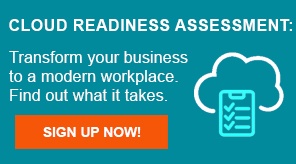IT & Cloud Strategy: Which IT Solution is Right for Your Business?
 If you’re here because your business is in a growth phase, kudos to you for excelling through one of the toughest times for small businesses in recent history! Perhaps you’re on the other end of the spectrum and your IT Manager left or you had a bad experience with an IT provider and you’re at a crossroad with what to do next. Either way this is a great opportunity for your business to take a fresh look at where you are today – what you’re doing right, what can be improved upon and how to get you to where you want to go. This is all part of the IT and cloud strategy for your business.
If you’re here because your business is in a growth phase, kudos to you for excelling through one of the toughest times for small businesses in recent history! Perhaps you’re on the other end of the spectrum and your IT Manager left or you had a bad experience with an IT provider and you’re at a crossroad with what to do next. Either way this is a great opportunity for your business to take a fresh look at where you are today – what you’re doing right, what can be improved upon and how to get you to where you want to go. This is all part of the IT and cloud strategy for your business.
It’s clear that Covid-19 made businesses realize the need to embrace new technology – not only to maintain or improve daily operations but to ensure a competitive advantage in the market. While the pandemic pushed businesses to think differently about technology to support both employees and customers, pressures to keep up with the speed and complexity of our world has been happening for decades. Businesses that embrace new technology like the cloud will set themselves up to better meet the need of employees, customers, and shareholders for years to come.
Why cloud strategy matters?
A cloud & IT strategy communicates the “why”, “how”, or even the “what” of cloud adoption. There are a several common pitfalls that businesses make when they start to think about the cloud and modern business technology.
- Making Reactive Moves. Companies that are able to make proactive decisions, grounded in their broader business strategy, are able to get ahead of the competition and set the standard for what great looks like
- Incomplete or Unclear Business Objectives. Businesses that are able to articulate what business opportunities will be unlocked through new technology adoption are far more likely to gain a competitive advantage.
- Focusing Purely on the Technology. Organizations that are seeking to gain a true competitive advantage through technology need to focus on behaviors, mindsets, and engagement in addition to tools, technology, and training. It’s critical to understand how each of your stakeholder groups need to interact with the technology to get the most out of it, and to create an environment that cultivates those behaviors.
Because you’re here doing your due diligence that means that you’re not making reactionary moves. You understand that IT is a critical business driver, and when aligned with your business goals, IT can provide profound competitive advantages. And when IT is not implemented correctly, when you don’t have the right solution or right support in place, it can be a real source of pain for any business.
Without a sound modern IT strategy, business groups and users will adopt solutions to increase productivity as they become available. Many organizations have already experienced this in the form of “Shadow IT”. The absence of a cloud strategy leaves these teams with little guidance for cloud service adoption leading to silos of technology, non-standard solution implementations, non-optimized costs, and greater exposure to risk from poorly configured environments.
Which IT Solution is Right for My Business?
This is a decision that you do not want to make in a vacuum. Selecting your IT solution should not be based on what you’ve done up until this point or your current IT skillsets. Which IT Solution is right for your business is NOT an IT decision. It’s a business decision, dependent upon your business strategy and desired business outcomes more than anything else. If you don’t spend the right amount of time planning and evaluating IT Solution for your SMB, you could end up investing in an outdated solution that will cause you headaches for many years to come.
In a few years from now the on-premises, legacy infrastructure will be a thing of the past. Sure, there are enterprises that will continue to maintain a local datacenter, but it will be virtualized, and it will be extremely expensive. Just like small and medium businesses, most enterprises are leading the way to the cloud because it’s the best solution available and it future proofs their investment.
>> Related Read: Pros and Cons of Cloud Computing for Small Businesses
There are several other factors to consider when evaluating the IT Solutions and the cloud. It’s important to know how, when and why you’re making those decisions. Some businesses move all of their workloads to the cloud at once, others move just a few workload while keeping other sensitive data on-premises. You can crawl, walk, run to the cloud, you can opt for a hybrid cloud solution and go at the pace that makes sense for your business -- all while still reaping the benefits of cloud computing.
But whether you invest in the cloud today or down the road, I can bet your bottom dollar that is where you will ultimately land in 3 years from now. So while you’re at the fork in the road, it’s best to take the time to make the right decision.
How to Evaluate Various IT Solutions? Start with an Assessment
FIRST determine which IT solution is right for your business, and THEN find the best IT support company for that solution. Not the other way around.
What does that mean for you? That means exploring different solutions, talking to and evaluating IT providers to determine whether their offerings are aligned with your business goals, and see how they compare to what your internal team is recommending.
Keep in mind, a good managed IT company will help you with this. They won’t try to force a square peg into a round hole. They won’t try to persuade you as to why you should choose their solution if it’s not the right fit.
Several third-party companies like ANP offer FREE IT Assessments to help you get started. Contact us today at (215) 572-0111 or email us at connect@anp.net to discuss your current IT situation or to setup your IT and Cloud Readiness Assessment.

